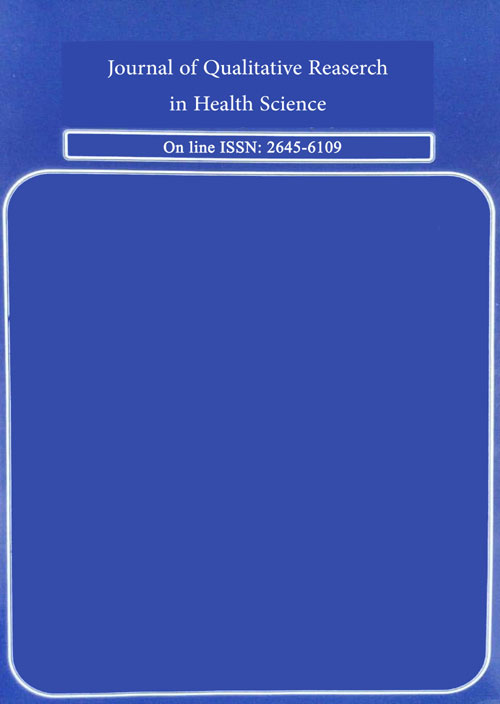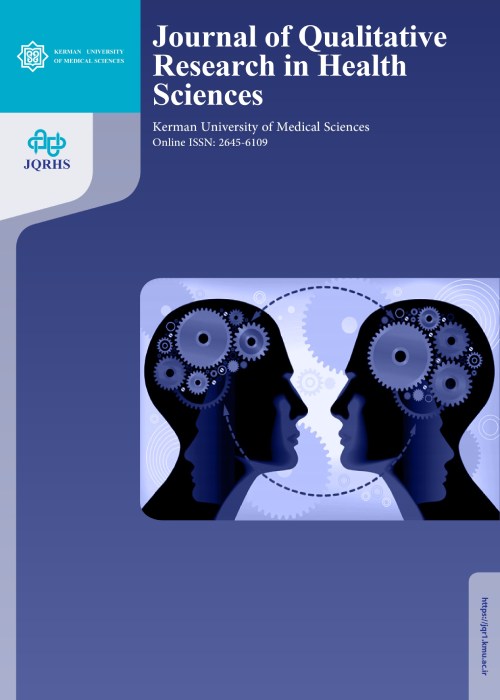فهرست مطالب

Journal of Qualitative Research in Health Sciences
Volume:11 Issue: 1, Spring 2022
- تاریخ انتشار: 1401/02/03
- تعداد عناوین: 8
-
-
Pages 1-9IntroductionExtramarital relationships are considered as one of the most serious threats to the stability of marital relations and family functioning, one of the main reasons for divorce, and one of the most critical issues faced by families. Accordingly, the present study aimed to explore extramarital relationships in women and find out social and cultural factors affecting such relationships.MethodsThis study was conducted qualitatively using a qualitative content analysis method. The data were collected to the theoretical saturation point through semi-structured interviews with 34 women.ResultsThe analysis of the participants’ experiences indicated that a set of cultural factors and major developments such as individualism, changing values and promoting alternative values, the absence of an authentic relationship, facilitating effects of technology and social media, changing women’s attitudes toward womanhood and its responsibilities, and diminution of religious and ideological beliefs play a role in the emergence and increase of extramarital relationships.ConclusionThe development of extramarital relationships in women is not just an individual phenomenon but a process influenced by many factors. Therefore, the role of cultural and social factors in the formation and increase of these relationships should not be underestimated.Keywords: Extramarital relationships, Cultural factors, Social factors, Women, qualitative research
-
Pages 10-18IntroductionA deeper understanding of generalized anxiety disorder (GAD) provides many clues to what causes anxiety disorders and what treatment is needed. The present study aimed to investigate the life experiences of patients with GAD comorbid with emotional disorders.MethodsThe present research was a qualitative one carried out based on the phenomenological approach. The participants in the study were 10 patients with GAD comorbid with emotional disorders who were selected using purposive sampling method based on data saturation. A semi-structured face-to-face interview was used to collect data. The texts of the interviews were analyzed by the phenomenological approach using Colaizzi’s seven-step method.ResultsThe results of analysis of data derived from the interviews revealed four main themes and 13 subthemes including components of illness (worry, cognitive component, behavioral component, emotional component, physiological component), influential factors (sociocultural factors, psychological vulnerability, developmental history), consequences of illness (quality-of-life impairment, interpersonal problems), and treatment (self-care, expectations of treatment, limitations and barriers to treatment .(ConclusionThe themes identified in this study by phenomenological method based on lived experiences of patients provided new information about the etiology, consequences, and treatment of this disorder.Keywords: Life experiences, Phenomenology, General anxiety disorder, Emotional disorder
-
Pages 19-26Introduction
Academic guidance and counseling, while providing insights into the right decision-making methods and how to deal with life events, can increase the efficiency of the educational system and reduce academic failure. Given the importance of having in-depth knowledge of faculty members’ opinions about counseling for evidence-based promotion, this study aimed to explore the challenges and facilitators of the academic counseling process.
MethodsThis qualitative study was conducted using Conventional content analysis to provide in-depth knowledge of the views of faculty members about the challenges and facilitators of the academic counseling process. The participants in this study were 24 faculty members from different schools of Hamadan University of Medical Sciences. They were selected through purposive sampling with maximum variation. The data were collected through semi-structured interviews with the participants.
ResultsThe analysis of the data showed that the challenges and facilitators of the academic counseling process fall under six main themes, eight main categories, and eleven subcategories. The main themes that emerged in this study concerning the challenges of the academic counselling process were the organizational need to improve the conditions of academic counseling, the counselor’s poor communication skills, and the student’s failure to refer for counseling. Furthermore, the three main themes regarding the facilitators of the consulting process were the correct administration of the counseling curriculum, improving the counseling skills of the faculty members, and the separation of the counselor’s role from the instructor’s role.
ConclusionThe consultation process at the university needs to be improved both in quality and in quantity. Therefore, empowering and equipping the consultant faculty members with adequate knowledge, attitudes, and skills through conducting effective training courses and workshops, and organizing briefing sessions to adjust students’ expectations of the counseling faculty members, seem to be necessary for the consultation process improvement.
Keywords: counseling, Perspectives, Challenges, Facilitators, Faculty members, Students -
Pages 27-34IntroductionAs searching and perceiving various aspects of human being are impossible by quantitative methods, it is important to use qualitative methods for disciplines that study human phenomena. Due to the development of the holistic paradigm in nursing, the naturalistic paradigm has received more attention. It emphasizes holism and is based on nursing philosophy such as structuralist and constructivist approaches which are both suitable for solving nursing problems. However, most articles use them interchangeably. This study aimed to explain structuralist and constructivist approaches.MethodsThis review study was conducted via searching certain databases including Google scholar, PubMed, SID, and ScienceDirect using “constructivism”, “structuralism”, “constructionism”, and “nursing” as keywords both in Persian and English in combination and separately, among published articles. The articles explaining the two approaches were studied.ResultsBoth constructivism and structuralism are qualitative methods. The structuralist approach makes sense of the background structures of patients. It replaces subjects with anonymous entities, irrespective of time. Constructivism helps to find out socio-economic and political factors of a social problem, emphasizing a construct formed in the observer’s mind. Both approaches are holistic and provide deeper understanding. They are used in most articles interchangeably, though.ConclusionConstructivism and structuralism, as approaches of naturalism, result in grasping human reaction, motivation, and feelings. They are appropriate approaches to unveil complex problems of health in nursing and detect the structures behind social realities. However, they are different in some respects such as the school of thought, the role of the researcher, and the purpose of data analysis.Keywords: Constructionist, Nursing Methodology Research, Natural Science Disciplines
-
Pages 35-41Introduction
The sudden onset and difficult consequences of COVID-19 pandemic are considered a trauma for healthcare. Despite its devastating consequences and psychological distress, it has also undergone positive changes. The main objective of this study was to explain post-traumatic growth among nurses and physicians during COVID-19 pandemic.
MethodsIn this study, a descriptive phenomenological approach was utilized and semi-structured interviews were conducted with 17 nurses and physicians who were selected by purposive sampling. The interviews were analyzed using Colizzi’s method.
ResultsThe findings of the study were summarized into two main themes: distress with four subthemes including corona and loss of life, psychological trauma, ambiguity and confusion about the career path, environmental and interpersonal stress, and growth with four subthemes including alternative ways to overcome trauma, promoting interpersonal relationships, empathy in treatment, and finding meaning.
ConclusionThe results of the present study revealed post-traumatic growth played an important role in maintaining the mental health of nurses and physicians beyond traumatic coronavirus pandemic. It is hoped that this study will encourage further exploration and examination of this subject and interventions for all groups of healthcare.
Keywords: Nurses, physicians, COVID-19, Post-traumatic growth, Qualitative research -
Pages 42-47Introduction
Marital relationship enrichment program is designed for couples who have relatively good relationship and desire to improve it. The enrichment program seeks to improve couples’ relationships and determine the factors and conditions upon which marital satisfaction and compatibility can be realized after marriage. The objective of this study was to analyze the components of marital relationship enrichment program using a qualitative method.
MethodsThis study was conducted using a qualitative method based on deductive content analysis. At first, 46 related sources (13 books, 30 papers, and 3 theses) were used to identify and extract the components related to enriching couples’ relationships. Purposive sampling was used and data collection continued until the data saturation point. Then, the relevant components were extracted and the obtained data were recorded and classified into codes, subthemes, and main themes based on the shared content.
ResultsThe data extracted in this study were classified into 52 codes, 21 subthemes, and 5 main themes. The main themes of enriching couples’ relationships included developing awareness and cognition, communication skills, emotional literacy, commitment to improve the relationship, and conflict resolution skills.
ConclusionTaking into account the results of this study concerning the components of enriching marital relationship can provide the necessary context for success in marriage.
Keywords: Marriage, qualitative research, Marital therapy, Marital relationship, Marital enrichment program -
Pages 50-57Introduction
Electronic Health Record (EHR) is an opportunity to implement healthcare services remotely especially in situations that social distance is necessary, such as in Covid-19 pandemic. The relationship between physician and patient is very important in medicine and it has been described as a basic axis of clinical measures and the foundation stone of proper activities in the health system. However, one of the main factors less considered in the design and deployment of health technologies is the physician-patient relationship, emotions, and feelings. The present study aimed to investigate the role of using electronic health records on physician-patient relationship.
MethodsIn this study, qualitative data collection was carried out via unstructured and semi-structured interviews and focus group discussion, using a phenomenological approach. A thematic analysis approach was also used to analyze the transcripts. A total of 24 participants, including eight physicians, three specialists (pediatricians, gynecologists, and psychiatrists), four psychologists, five health care providers, and four chief executive officers were selected using purposive sampling.
ResultsThe results of this study revealed using EHR could influence interpersonal communication as well as empathetic and sympathetic relationship between physician and patient. The relevant classes are explained in detail in the main text of the article.
ConclusionWhile EHR is beneficial, the concerns overshadowing the interactions between physician and patient cause users to change their perception of the benefits and efficiency of EHR.
Keywords: Relationship, Physician-patient, Electronic Health Record (EHR), Healthcare -
Pages 58-60
Phenomenology of practice is a useful method for deeply understanding human phenomena and is fundamentally practical. Its ultimate goal is to nurture thoughtfulness and tact in the practice of professions. Pathic knowledge is a type of non-cognitive knowledge which is obtained through phenomenology of practice and can provide a lens for teachers and students to reflect on their teaching and learning experiences through their relationships, their situations, and their acts. From Van Manen’s point of view, what distinguishes practice from theory is not that practice exerts thought and concepts in the real world; rather, phenomenology of practice involves a different path of recognizing the world. It is very important in medical education due to the importance of communication and human interactions. In this letter, the author highlighted the importance of pathic knowledge in medical education as a part of professional knowledge.
Keywords: Phenomenology of practice, pathic knowledge, medical education


